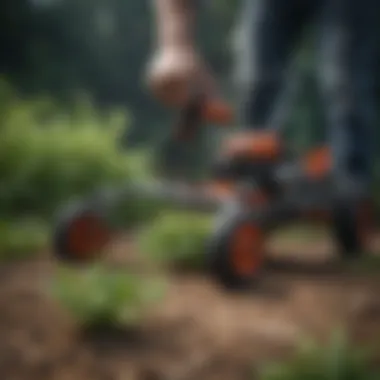Effective Weed Management Techniques for All Gardeners


Intro
Managing weed populations is no small feat. Homeowners and gardening enthusiasts often find themselves facing the relentless advance of weeds, which can choke the life out of prized plants and disrupt the natural balance of a garden. This article dives into the myriad strategies available for effective weed management, alongside an assessment of both traditional methods and modern techniques. With an emphasis on practical applications and sustainability, understanding these strategies can turn an uphill battle into a manageable task.
The insights and knowledge you gain here are not just for the green-thumbed gurus. Whether you’re a novice gardener in your backyard or someone looking to maintain a lush interior space filled with greenery, this guide is crafted for you. With that, you’ll also never look at those pesky weeds in quite the same way again.
Key Insights and Trends
Current Trends in Weed Management
Several noteworthy trends have emerged in the realm of weed management. Firstly, the shift towards organic practices is gaining momentum. Homeowners increasingly opt for eco-friendly products that don’t harm beneficial insects or the surrounding ecosystem. Techniques such as mulch application and ground cover planting are on the rise, providing natural barriers to weed proliferation.
Moreover, technological advancements such as precision agriculture have opened doors to more effective weed management. Drones and smart sensors now assist homeowners in identifying specific weed species and their growth patterns. This allows for targeted treatment, reducing resource waste and enhancing effectiveness.
Popular Gardening Techniques of the Season
In addition, various gardening methods have captured attention this season.
- Permaculture is at the forefront, promoting biodiversity and resilience.
- No-till gardening is another method gaining traction, preserving soil quality while minimizing disturbance to the ecosystem.
- Regenerative practices are also being embraced by a growing number of gardeners, focusing on revitalizing the soil and promoting plant health.
These innovations suggest a robust movement towards more sustainable gardening practices, blending traditional wisdom with modern science.
Practical Tips and How-To Guides
Knowing the why behind weed growth is crucial, but knowing the how of managing them is where the real action lies. Below are some practical tips to arm you against invasive species in your garden:
Step-by-step Guides for Effective Weed Management
- Regular Monitoring: Make it a habit to check your garden weekly for any signs of weeds popping up. Early detection can make a world of difference.
- Mulching: Apply a thick layer of organic mulch around plants to suppress weed growth. It not only retains moisture but also adds nutrients to the soil as it breaks down.
- Hand-Pulling Weeds: For smaller infestations, hand-pulling is effective. Ensure you remove the entire root system to prevent regrowth.
- Planting Cover Crops: Use cover crops during off-seasons. They prevent weed seed germination and improve soil health.
- Using Vinegar as a Natural Herbicide: Spray white vinegar directly on weeds during sunny days. The acetic acid will desiccate them, but be careful to avoid your desirable plants.
"Employing a combination of these methods can greatly reduce weed pressure in any landscape, combining the ancient and the innovative in weed management."
Stay tuned as we explore further into the science behind weeds and the ecological ramifications of their management.
Understanding Weeds
Weeds are often dismissed as mere nuisances, but understanding them is crucial for effective management. By exploring the intricacies of weed biology and behavior, gardeners gain a competitive edge in the perennial struggle to maintain their green spaces. Comprehending the traits of these unwelcome plants enables both preventative measures and targeted interventions to be implemented effectively. If you’ve ever pulled out a weed only to watch it return with a vengeance, you know that a deeper knowledge can save time and frustration.
Characteristics of Common Weeds
Identification features
Identifying weeds isn't just about knowing what they look like; it’s about understanding their growth patterns and distinguishing features. Common weeds like dandelions or crabgrass often have overlapping characteristics that can confuse novice gardeners. Key identification traits often include leaf shape, flower type, and growth patterns. Understanding these traits helps in early identification and resource allocation. For example, broadleaf weeds, like chickweed, tend to have soft, wider leaves compared to the needle-like leaves found in grass weeds. This knowledge can give gardeners a leg up in early intervention.
One major benefit of recognizing these traits is the ability to prioritize materials and methods for removal. Specific tools can be more effective against certain weed types, saving effort and resources. However, reliance on identifying features without considering growth habits can lead to misidentification and ineffective control strategies.
Growth habits
The growth habits of weeds can vary significantly, influencing when and how they best removed. Some weeds germinate rapidly, like foxtail, while others may take their sweet time but spread aggressively, such as bindweed. A clear understanding of these habits enables gardeners to cultivate favorable conditions for desired plants instead. This allows for smarter planning, such as adjusting sowing dates or choosing plants that may outcompete or shade out these interlopers.
An essential point to note is that growth habits can also inform everybody about seasonality and life cycles of weeds. Perennial weeds often return year after year, while annual weeds can be managed by disrupting their seed bank. Thus, through recognizing growth habits, one can develop a more targeted and efficient management plan, minimizing future headaches.
Reproductive strategies
Weeds are often quite adept at reproducing, making them formidable foes in the garden. Many employ strategies such as prolific seed production, vegetative reproduction, and even hybridization with cultivated plants. Take, for instance, the common thistle, which can generate thousands of seeds from a single flower head. This capacity for rapid multiplication underscores weed resilience, making it crucial to address them before they take hold.
Understanding these reproductive strategies allows gardeners to anticipate weed outbreaks effectively. Addressing weeds before they flower and set seeds, for example, not only curtails a single infestation but can break the cycle of emergence for future generations of the plant, reducing overall population in the long run.
The Ecological Role of Weeds
Biodiversity impact
Weeds can wield surprising influence over biodiversity within an ecosystem. They can serve as food sources for various insects and other animals. Surprisingly, some weeds are also attractive for beneficial insects that provide natural pest control. Thus, while they are often seen as harmful, they can play important roles through their interactions with other elements in the landscape.
When managing weeds, acknowledging their roles in biodiversity can open avenues for more holistic approaches. For instance, leaving certain weedy species undisturbed could enhance overall ecological balance. However, overabundance or dominance of weed species can overshadow more desirable vegetation, representing a double-edged sword.
Soil health contributions
Maybe not so intuitively, weeds can contribute positively to soil health. They can help prevent erosion, improve soil structure, and enhance nutrient cycling. For instance, deep-rooted weeds penetrate the soil, contributing channels for air and water, potentially enhancing soil permeability. This can improve the health of the entire garden by creating pockets of aeration and drainage.
Nevertheless, reliance on weeds for soil health can be misleading. They might also deplete soil nutrients crucial for cultivated plants or harbor diseases. Therefore, while understanding their contributions offers insight into soil dynamics, balance is key for a thriving ecosystem.
Feeding relationships
The relationship between weeds and the creatures they attract or repel is intricate. Certain weeds can foster populations of pollinators providing a critical service to flowering crops nearby; other weeds can act as hosts for pests we do not want near our plants. This relationship can shape management practices.
Emphasizing feeding relationships helps promote an intelligent approach to gardening. It reaffirms the idea that rather than seeing weeds as solely malevolent, they can participate in the intricate food webs of ecosystems. However, heavy infestations might shift these dynamics unfavorably, underscoring that thoughtful intervention may still be needed to maintain balance.
In sum, understanding weeds offers invaluable insights into their characteristics and behaviors, ultimately leading to enhanced gardening practices and a healthier ecosystem.
Cultural Weed Control Methods
Cultural weed control methods are indispensable when it comes to managing weeds effectively in gardening and agricultural environments. They revolve around utilizing agronomic practices that directly affect weed growth and establishment, enabling one to cultivate desirable plants while restricting weed proliferation. By employing these methods, gardeners not only contribute to better crop yields but also strengthen soil health and enhance biodiversity. Here, we will delve into various techniques, starting with soil preparation, followed by crop rotation, both of which form the bedrock of successful weed management.


Soil Preparation Techniques
Proper soil preparation is crucial for establishing a garden that's not only productive but also robust against weed encroachment. The way soil is worked sets the stage for what grows, and proper tilling methods are key to managing weeds effectively.
Proper Tilling Methods
Tilling the soil can either hinder or support weed growth, depending on how it's done. Traditional practices often involve deep tilling, which can disrupt soil structure and lead to increased weed seeds' germination. On the flip side, shallow tilling encourages shallow-rooted crops while minimizing disturbance to the soil depth. This method is a beneficial choice because it helps preserve the ecological balance, allowing beneficial organisms to thrive.
One unique feature of shallow tilling is that it helps to bury weed seeds deeper, preventing them from sprouting on the surface. However, over-relying on tilling may lead to soil erosion and degradation in the long run. Therefore, a thoughtful approach, taking soil type and moisture into account, is essential.
Organic Amendments
Incorporating organic amendments is another cornerstone of cultural weed control. These can include compost, aged manure, or green manure, which not only enrich the soil but also help in suppressing weed growth. The key characteristic of organic amendments is their ability to elevate overall soil health, providing essential nutrients to crops while competing with weeds for resources.
A distinctive benefit of organic amendments is their capacity to improve soil structure, leading to enhanced water retention and aeration. Yet, their effectiveness can depend on application methods and timing, potentially requiring periodic assessments to gauge their impact.
Cover Cropping Benefits
Utilizing cover crops is a strategy that has gained traction in recent years. They act as living mulch, smothering weeds while enhancing soil health. The primary advantage of cover cropping lies in its dual role: it suppresses weeds and replenishes soil nutrients, particularly nitrogen.
By planting diverse species, gardeners create a more resilient environment. However, one downside to consider is that cover crops can also attract unwanted pests and diseases if not managed properly. Careful selection and timing of cover crops can mitigate such risks, making them an excellent option in a comprehensive weed management plan.
Crop Rotation as a Preventive Measure
Crop rotation is a preventive measure that can significantly reduce weed problems by disrupting the life cycles of weeds. By alternating plant species, gardeners can target specific weed families, preventing them from establishing a firm hold.
Benefits of Diverse Planting
The benefits of diverse planting cannot be overstated. By rotating crops, one introduces various root structures and canopy heights, which can confuse weed growth patterns. This method’s key characteristic is its ability to break cycles of weed germination, effectively managing populations over time.
Moreover, diverse planting can enhance soil fertility and reduce the need for chemical interventions. Nevertheless, it necessitates advanced planning and knowledge of which crops to rotate, potentially complicating garden management for novices.
Timing Considerations
Timing is essential in the implementation of crop rotation strategies. Understanding the germination and life cycles of both crops and weeds helps determine the optimal times for planting and harvesting. Well-timed rotation can maximize crop yield while minimizing weed emergence, which is a beneficial outcome in any integrated weed management system.
An interesting aspect of timing considerations is that they can vary greatly based on local climates and soil conditions. Local knowledge can provide critical insights, ensuring that the right measures are executed at the right times.
Pest and Weed Suppression
The suppression of pests and weeds through crop rotation is a vital strategy. Different crops can attract diverse pest populations, effectively confusing those that target specific plants. By rotating crops, gardeners can distract and mitigate both pests and weeds, decreasing their impact on yields.
One particularly appealing feature of this method is its sustainability; it reduces reliance on chemical pesticides and herbicides. On the downside, it does require consistent monitoring and management to ensure effectiveness, especially in organic systems where pest populations might fluctuate more significantly.
By employing cultural control methods, gardeners cultivate a healthier, sustainable ecosystem where plants thrive while weeds take a back seat. These practices not only help in managing weeds but also promote an enriching environment for the entire garden.]
Utilizing soil preparation techniques alongside crop rotation forms a comprehensive approach to weed management. Gardeners and homeowners alike can reap the benefits by understanding and implementing these methods effectively.
Mechanical Control Strategies
Mechanical weed control strategies comprise a range of techniques for physically removing or damaging weeds, offering an effective alternative to chemical methods. These strategies are not just a throwback to old gardening methods; they hold significant value in modern practices aimed at sustainable land management. The core benefit lies in their ability to minimize chemical inputs, thereby reducing potential environmental impact and health risks associated with herbicides. Moreover, mechanical strategies can be tailored to the specific needs of a garden or landscape, ensuring that each situation is met with a suitable solution. This section will delve into two significant approaches: hand weeding techniques and the employment of specialized equipment.
Hand Weeding Techniques
Effective tools for hand weeding
Hand weeding is both an art and a science that requires the right tools to achieve the desired results. Using the right implements, such as the traditional hoe or a specialized hand weeder, can make a world of difference in efficiency and effectiveness. One of the key characteristics of these tools is their ability to reach out into narrow spaces where larger machinery simply cannot fit. This means that even in densely planted gardens, you can pick out pesky weeds without disturbing surrounding flora.
The advantage of these tools is their accessibility. They don’t require much investment and can be handled with ease by gardeners of varied experience levels. However, persistence is key; hand weeding can become labor-intensive, particularly in larger areas or when addressing stubborn weed types that have deep roots.
Best practices for removal
Best practices for removing weeds go hand in hand with the tools you choose. One crucial aspect is to ensure that you are pulling weeds out from the root to stop them from growing back. This practice is crucial because many weeds, like dandelions, can regenerate from broken roots left in the soil. Effective hand weeding should be performed when the soil is moist, as it facilitates easier root removal.
Another significant factor is timing. Tackling weeds early in the season, before they set seeds, can effectively control their spread. However, hand weeding may not be suitable for all circumstances, such as areas plagued by invasive species with rapid growth rates, where you need to employ more aggressive methods alongside.
Timing and persistence
Timing and persistence can be your best friends when embarking on a hand weeding mission. Each weed has its life cycle, and understanding when they are most vulnerable—perhaps just after rainfall—can lead to more fruitful outcomes. Regular attention to weeding in your garden significantly reduces the seed bank in the soil, which means fewer weeds to deal with in future seasons.
While hand weeding consistently can sound tedious, the practice builds an intimate knowledge of your landscape and can actually become embroiled in the gardening experience itself. The downside is the time commitment, as it does require regular commitment and diligence, which may not work for everyone.
Using Specialized Equipment
Types of mechanical weeders
Specialized equipment introduces efficiency into weed management on a larger scale. Mechanical weeders come in various forms, including rotary hoe, flame weeder, and tillers, each serving specific purposes suited to different garden types. Their main function is to uproot weeds and create unfavorable conditions for them within the garden.
For instance, a flame weeder utilizes heat to damage the cell structure of young plants, effectively stopping them in their tracks. It's a beneficial choice for both organic gardeners aiming to avoid chemicals and for those tackling extensive weed populations quickly. On the downside, improper use could result in unintended damage to nearby desirable plants, highlighting the need for careful application and attention.
Cost-benefit analysis
When evaluating any specialized equipment, a cost-benefit analysis becomes essential. It's vital to consider the initial investment against long-term benefits. While tools like a tractor-mounted cultivator can be costly, they can save considerable time and labor in maintaining larger plots of land, offsetting that initial price over time.
Additionally, look beyond just the purchase price. Assess maintenance costs, possible labor reduction, and even the yield increase from a healthier garden as part of your analysis. However, keep in mind the potential for equipment to become underused if your gardening needs scale down.


Efficiency in large areas
For those managing extensive gardens or agricultural settings, the efficiency of mechanical methods is potentially unmatched. Employing large machinery can dramatically reduce time spent on manual efforts, allowing for a focus on other important garden tasks or strategic expansion.
However, efficiency doesn't come without consideration. The soil structure and microbial community can be negatively impacted with the repeated use of heavy machinery and can lead to soil compaction if not monitored closely. Also, some weeds may become resistant if mechanical controls are not appropriately timed or varied. Balancing efficiency with ecological impact ensures that your weed management strategies yield the best results without compromising the health of your garden.
Chemical Control Options
Chemical control options play a pivotal role in managing weed populations effectively. While there are several methods of weed control, the use of chemicals, refered to as herbicides, often stands out due to its potential for rapid action and wide applicability. These chemicals can significantly reduce the competition that weeds impose on crops or ornamental plants. However, with great power comes the necessity of responsibility; understanding the proper use and implications of these options is crucial for achieving the desired outcomes without degrading the ecosystem.
Understanding Herbicides
Types of Herbicides
Herbicides can be broadly classified into two categories: selective and non-selective. Selective herbicides are formulated to target specific weed species without harming desirable plants, making them a go-to choice for gardeners wanting to maintain the integrity of their main crops while minimizing weed disturbance. On the other hand, non-selective herbicides obliterate any plant material they come in contact with, which may be useful in areas where no plants are desired. A unique feature of selective herbicides is their mechanism of action that often disrupts specific physiological processes in the targeted weeds, like photosynthesis or amino acid synthesis.
Advantages of using selective herbicides include the preservation of desired flora, while a disadvantage is the possible escape of non-target weeds that could develop resistance to the product. Hence, the choice of herbicide type should align with the gardener's goals and the specific weeds being tackled.
Application Techniques
When it comes to application techniques, precision is the name of the game. The two primary methods are spot treatment and broad-area application. Spot treatment involves applying herbicides directly to the weed, reducing the likelihood of affecting surrounding plants. This method tends to minimize unnecessary chemical exposure to the environment. Broad-area applications are often used for large infestations but require careful planning to avoid drift or runoff, which could harm non-target species.
The ease of use of backpack sprayers or hand-held applicators often makes spot treatment a popular choice, particularly for small gardens. However, larger spaces may necessitate specialized equipment, such as tractor-mounted sprayers, which can apply herbicides quickly yet may lead to over-application if not closely monitored. Thus, understanding the context of use is essential for optimizing the benefits of these techniques.
Environmental Considerations
Environmental considerations are paramount when discussing chemical control options. It’s essential to take into account the potential effects of herbicides on surrounding ecosystems. For instance, herbicide runoff into water bodies can have dire effects on aquatic life, further highlighting the importance of proper application practices. Additionally, the role of soil health cannot be overstated; certain herbicides can disrupt microbial populations that contribute to a thriving soil ecosystem.
A responsible approach involves understanding the specific characteristics of the chosen herbicide, including its persistence in the environment and its potential for bioaccumulation. Using products that break down quickly in healthy soils can minimize long-lasting negative impacts. Ultimately, the key takeaway here is that while chemical control can be highly effective, it must be managed mindfully to protect the integrity of the broader ecosystem.
When to Use Chemical Solutions
Signs of Critical Weed Infestations
Recognizing the signs of critical weed infestations is a crucial skill for any gardener looking to integrate chemical solutions effectively. Weeds tend to engage in specific behaviors that can signify their encroachment. Notably, when weeds begin flowering or producing seeds, that’s a call for action. At this stage, control becomes imperative as these weeds can quickly spread, leading to more pronounced competition for resources.
One of the strengths of identifying critical infestations is the time sensitivity involved; acting promptly can help curb potential growth before it spirals out of control. However, the somewhat surprising downside is that, in some cases, established weeds can re-root even after treatment, making preemptive identification vital.
Integration with Other Controls
The integration of chemical solutions with other weed control methods enhances overall effectiveness. For instance, utilizing mechanical removal methods in tandem with strategic herbicide applications can yield a well-rounded approach that covers different facets of weed control. A key aspect to keep in mind is that some mechanical methods may stimulate weed growth, necessitating a careful balancing act between the two approaches.
Moreover, synergistically combining these strategies can lead to more efficient resource use, tackling various weed life stages from seedlings to mature plants. In this way, integration sets the stage for a thorough system of control. However, it's crucial to track the responses of the flora involved to adjust tactics accordingly.
Long-Term Impact Assessments
Finally, long-term impact assessments call for a close examination of the consequences of using chemical weed control. This action is pivotal for understanding cumulative effects on soil health, native species, and overall ecosystem balance. Assessments often include evaluating soil chemistry over seasons and monitoring shifts in plant communities due to herbicide application.
A unique advantage of conducting long-term studies is the potential discovery of more sustainable practices to replace or augment chemical use, benefiting garden health in the long run. However, it’s worth noting that short-term assessments can sometimes fail to account for delayed effects; thus, relying on thorough extended evaluations can offer a more comprehensive picture of ecological impacts.
Biological Control Methods
Biological control methods offer a dynamic approach to weed management, drawing upon natural systems to mitigate unwanted plant growth. By harnessing the power of nature—be it through the introduction of natural predators or utilizing synergistic planting techniques—gardeners can create a more balanced ecosystem. This method not only reduces the reliance on harsh chemicals but also fosters a healthier garden environment.
Utilizing Natural Predators
Types of beneficial insects
Natural predators play a pivotal role in biological control, primarily by preying on weed species and their seedlings. For example, ladybugs and lacewings are commonly known for their voracious appetites for aphids but also help regulate the populations of certain weeds by feasting on the insects that may promote their growth. One key characteristic of these beneficial insects is that they are specific, often seeking out certain pests rather than applying their effects indiscriminately. This selectiveness provides a targeted approach that minimizes disruption to other plant species. However, it’s important to note that the effectiveness of these predators can be influenced by environmental factors, such as availability of habitats and food sources.
Inter-planting strategies
Inter-planting strategies leverage the strengths of diverse plant species to naturally inhibit weed growth. This method involves placing compatible crops and plants in close proximity to each other. A notable example is combining corn with beans or squash, a practice seen in traditional Native American agriculture, famously known as the "Three Sisters" planting. This method enhances soil nutrients and light competition, ultimately improving yield and reducing weed presence. One defining trait of inter-planting is its capacity to exploit various ecological niches, allowing plants to thrive with minimal resource competition. One downside might be that improper planning can lead to resource contention, thus nullifying the sought benefits.
Creating conducive habitats
Creating conducive habitats for beneficial organisms involves developing an environment that supports the survival and reproduction of natural predators. This might include planting wildflowers to attract pollinators and predatory insects. The key feature of this approach is its dual purpose: while promoting biodiversity, it also creates an ecosystem that naturally regulates weed populations. Conditions such as providing shelter and varied food sources enable these organisms to thrive and, in turn, control weeds more effectively. Nevertheless, gardeners must consider that such habitats need ongoing management to ensure they remain beneficial and do not inadvertently become a sanctuary for pests.
Planting Companion Species
Mutual benefits with certain plants
Planting companion species enhances the biological dynamics within gardens. This practice involves selecting plants that not only coexist harmoniously but also provide benefits to one another. For instance, a well-known pairing is basil with tomatoes, where basil repels pests that typically target tomatoes. This mutual benefit is an essential aspect of companion planting as it reduces weed competition and pest populations. One unique feature of this approach is that it often results in healthier plants and better crop yields. Still, choice of companions requires careful planning and understanding of each plant's growth patterns to avoid overshadowing or nutrient competition.
Impact on weed suppression
The impact of various companion species on weed suppression is significant; it contributes to the overall resilience of the garden ecosystem. Commonly, fast-growing plants can shade out potential weeds, limiting their access to sunlight and resources. Additionally, certain deep-rooted plants can suppress weed growth by altering soil composition and moisture levels. One attractive characteristic of using plants for suppression is their compatibility with organic gardening principles. Despite these advantages, it is imperative to monitor the growth of companion plants to ensure they do not stifle desired crops, leading to unintended consequences.
Designing companion layouts
Designing companion layouts is an art that considers the spatial and functional relationships between different plants. Effective layouts often employ patterns that optimize light and resource sharing. For instance, the checkerboard pattern can help maximize space while allowing proper air circulation. This thoughtful arrangement prevents overcrowding, which can inhibit growth and create a haven for weeds. However, gardeners must remember that a one-size-fits-all approach doesn't work; individual growth habits and needs must be taken into account.
Crafting a successful garden ecosystem goes beyond just planting; it's about understanding the complex interactions between species.


Sustainable Practices in Weed Management
Sustainable practices in weed management represent an essential approach for any gardener aiming to foster a thriving ecosystem while keeping those pesky plants at bay. One of the most pivotal aspects is its emphasis on long-term solutions over short-term fixes. These practices not only target the weeds themselves but also enhance the overall health of the garden environment. Through methods like permaculture principles and organic alternatives, gardeners can mitigate the impact of weeds while promoting biodiversity and soil vitality.
Permaculture Principles
Integrating with natural ecosystems
Integrating with natural ecosystems hinges on the belief that a garden thrives best when it mimics nature's own patterns. This approach encourages diversity, leveraging the interactions among plants, insects, and soil. Ideally, when a garden reflects local biodiversity, it attracts beneficial organisms that help control weed populations naturally. The key characteristic of this method is its self-sustaining nature, which allows for minimal intervention over time.
One unique feature of integrating with natural ecosystems is the creation of habitats for predatory species. This adds layers of complexity to pest and weed management, helping to tip the scales in favor of desired plants. However, the downside is the time required for this system to establish a balance between the different elements, meaning patience is required.
Minimizing disturbances
Minimizing disturbances is another cornerstone of sustainable weed management. The premise is straightforward: less disruption leads to healthier soil and ecosystems. One key characteristic of this approach is its reliance on light touch farming methods such as no-till practices. This has been shown to bolster soil structure and encourage the presence of vital organisms that can combat weeds.
A significant advantage of minimizing disturbances lies in the reduction of erosion and the preservation of moisture in the soil. However, it requires a shift in mindset from conventional farming techniques, which can be challenging for those used to more aggressive methods of control.
Long-term soil health
Long-term soil health is fundamental to achieving sustainable weed management. It emphasizes nurturing the soil's biological and chemical properties to create a robust growth environment. This strategy not only affects the immediate area but also has broader implications for entire ecosystems. A key characteristic here is the commitment to organic amendments like composting, which enrich the soil.
One unique feature of focusing on long-term soil health is its adaptability to various cropping systems. Healthier soils can better support a wider range of plants, which in turn can combat weeds more effectively. Yet, the challenge is that implementing these practices often necessitates a shift in traditional gardening habits, making it harder for some to fully embrace.
Organic Alternatives to Conventional Methods
Homemade solutions and DIY options
Homemade solutions and DIY options offer a significant opportunity for gardeners looking to eschew chemical solutions. This approach encourages creativity and a tailored response to individual garden needs. A major characteristic of this method is the accessibility; everyday household items can often serve as effective weed deterrents. For example, a simple solution of vinegar can act as an excellent herbicide in small patches.
The unique feature of these homemade options lies in their customizability. Each gardener can experiment with ratios and ingredients to find what works best for their specific environment. On the flip side, effectiveness can vary, necessitating a good bit of trial and error.
Eco-friendly products
Eco-friendly products contribute significantly to sustainable practices in weed management by providing non-toxic alternatives to conventional chemical herbicides. These products, often made from natural ingredients, pose less risk to beneficial insects and overall garden health. The key characteristic here is their formulation, which typically avoids harsh chemicals that can leach into groundwater or disrupt local ecosystems.
One unique feature of eco-friendly products is their ability to fit seamlessly into a garden's ecosystem, working alongside native plants and insects rather than against them. While they tend to be gentler, it’s important to note that they may not always provide immediate results compared to traditional methods.
Assessing effectiveness
Assessing effectiveness in the realm of weed management is vital for understanding what strategies work best in a particular garden setting. This involves evaluating not just the immediate impact on weed populations but also the long-term implications for soil and plant health. The key characteristic of this ongoing assessment approach is its requirement for diligence from gardeners, as it compels them to regularly document and analyze practices, prompting a level of interaction with their space that may not occur otherwise.
A unique feature of assessing effectiveness is the potential to discover unexpected correlations between weed presence and specific environmental conditions, such as soil pH or moisture levels. That said, the challenge lies in the discipline required for systematic observation, making it a less attractive option for some casual gardeners.
"Sustainable practices provide long-lasting solutions that enrich both the garden and the gardener's experience. Every weed conquered is a step towards a richer ecosystem!"
In summary, embracing sustainable practices in weed management is not merely a trend but a necessity for fostering healthy and resilient gardens. Integrating with natural ecosystems, minimizing disturbances, focusing on long-term soil health, utilizing homemade solutions, and discovering eco-friendly products are all facets of this holistic approach. By adopting these techniques, gardeners can not only battle weeds but also enrich the health and vibrancy of their garden for the long haul.
Maintaining a Healthy Garden Ecosystem
A healthy garden ecosystem is fundamental when it comes to effective weed management. It is not just about keeping weeds at bay; it involves fostering an environment where plants, soil, and wildlife harmonize. This synergy can lead to reduced weed pressure and enhanced growth of desired plants. By paying attention to ecological balance and sustainability principles, gardeners can develop strategies that naturally minimize weed problems while creating a robust habitat for beneficial organisms.
Soil Health Management
Importance of organic matter
Organic matter is often regarded as the soul of healthy soil. It provides essential nutrients that plants thrive on. When organic material, like compost or well-rotted manure, is mixed into the soil, it not only enriches it but also improves its structure. The crumbly texture allows for better water retention and air circulation. A key characteristic of organic matter is its role in fostering a diverse microbial community, which contributes to nutrient cycling.
The advantage of incorporating organic matter lies in its dual benefits: it feeds plants while increasing soil fertility over time. On the flip side, if one relies solely on chemical fertilizers, the long-term soil productivity may decrease, leading to nutrient depletion.
Soil testing and amendments
Soil testing is a vital practice in garden management. By analyzing soil composition, gardeners can understand nutrient deficiencies and pH imbalances. This insight informs amendments, ensuring the right nutrients are provided. A key feature of soil testing is its ability to tailor care based on specific garden needs, rather than a one-size-fits-all approach.
This precision can effectively enhance plant health, as nutrient amendments can be applied strategically. However, one ought to be cautious; excessive amendments can lead to problems like nutrient runoff, which could harm surrounding ecosystems.
Fostering microbial activity
Microbial activity significantly contributes to soil health. These tiny organisms break down organic matter, releasing nutrients in forms that plants can absorb. Enhancing microbial life is beneficial because it leads to improved soil structure, nutrient availability, and disease resistance. A unique characteristic of fostering microbial activity is the introduction of specific practices like cover cropping and mulching, which add organic material and keep soil covered.
However, it's crucial not to disturb the soil excessively, as too much tilling can disrupt these beneficial communities. Maintaining a balance will ensure that microbial populations remain robust, supporting the overall garden health.
Creating Biodiversity
Native plants and their benefits
Incorporating native plants into a garden is a strategy with multiple benefits. These species are adapted to the local environment, which means they often require less maintenance and are more resilient to pests and disease. A notable characteristic of native plants is their ability to form synergistic relationships with local wildlife, including pollinators and other beneficial insects.
The use of native plants can contribute to reduced dependence on chemical inputs while supporting local ecosystems. However, success requires an understanding of the specific local flora; otherwise, non-native plants could take over and threaten established native species.
Encouraging pollinators
Pollinators play a crucial role in any garden ecosystem, as they contribute to plant reproduction and help maintain biodiversity. By creating habitats that attract pollinators, gardeners enhance their gardens' productivity. The key characteristic of encouraging pollinators involves providing diverse plants that bloom throughout different seasons.
This approach supports beneficial insect populations, which in turn help control weed populations naturally. However, one must ensure that plants used in gardens do not attract pest species that might overshadow the benefits of pollinators.
Improving ecosystem resilience
A resilient garden ecosystem can adapt to disturbances such as drought, pests, and diseases. Improving resilience often involves strategies like increasing plant diversity and developing deep-rooted plant systems that stabilize soils. The key aspect of resilience is its ability to recover from adverse conditions, allowing for ongoing productivity.
A unique aspect of fostering resilience is understanding how interconnected the various elements of a garden are. While many may focus solely on above-ground growth, it's essential to recognize that soil health, plant choices, and community interactions all play a role. Neglecting any ingredient in this recipe could lead to cascading failures in the garden environment.



